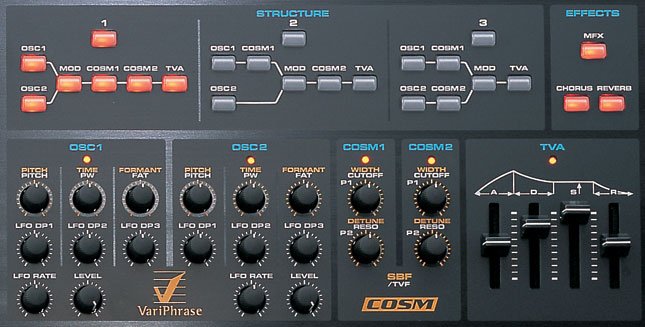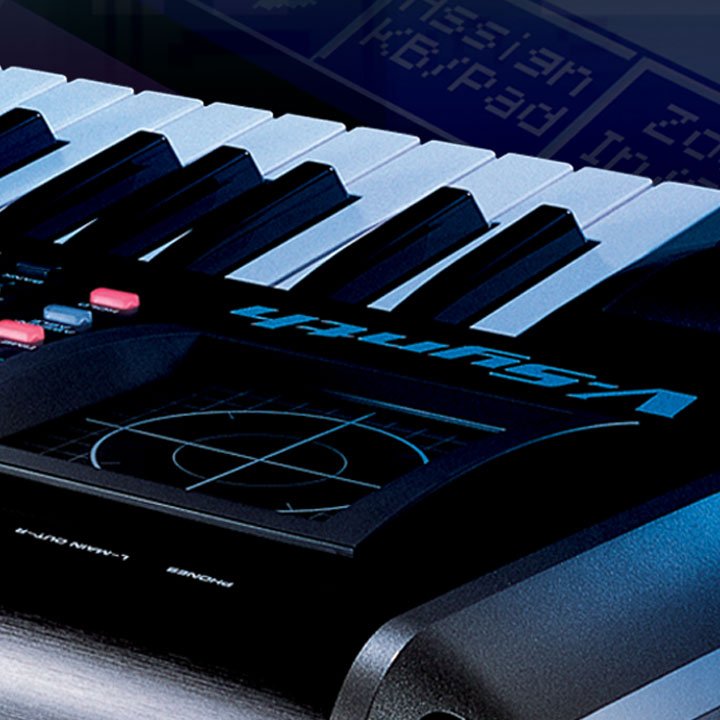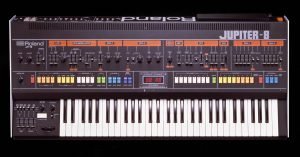Everything you need to know about Roland’s V-Synth technology.
The Roland V-Synth combines multiple oscillator technologies with real time control of a waveform’s pitch, time and formant. It also adds user sampling to create entirely new waveforms and uses powerful COSM filtering.
This technology lets you independently manipulate the pitch, time and formant of sampled waveforms using VariPhrase technology. On it’s introduction, it was a world’s first in synthesiser technology!
What is COSM?
The V-Synth engine included powerful COSM processing including filter modelling, resonator and a Side Band Filter plus global reverb, chorus and multi-effects.
COSM (Composite Object Sound Modelling) is a powerful modelling technology that Roland introduced in 1995. Initially it came out with the VG-8 V Guitar System. It emulates a range of classic and modern guitar amps, cabinets, and microphones. It can also produce “futuristic” synth-like tones.
Today COSM can be found in keyboards, digital recorders, mixers, etc. It can model rotary effects and different speaker colorations. COSM can even simulate the sound of expensive microphones using just an ordinary dynamic mic. It’s name comes from “composite object”. This is because its core function revolves around breaking audio producing or reproducing devices down to their component parts. It then creates a set of instructions to emulate how these various parts interact with each other. The result is to produce a new composite that can be dynamically controlled.
What are the three different type of oscillators in V-Synth technology?

V-Synth’s variable oscillator with VariPhrase technology brings life to otherwise static waveforms. And it’s not just the sound engine, but the way players can interact with it.
The V-Synth’s dual oscillators were unlike any oscillator design before it. They came with a choice of three different types:
The PCM oscillator is powered by VariPhrase for complete sonic control. You are able to choose from hundreds of preset waveforms or sample your own. Then use the “Time Trip” function to manipulate a waveform’s time aspect in any way you wish. Slow it down to uncover rich moving harmonic content. Speed it up to create high-speed tonal motion. Freeze it at your favorite spot or rewind it backward at any speed without changing pitch and formant, which can also be independently controlled. At it’s time of release, it created sounds never heard before!
Analog Modeling is the second oscillator type. With this you find nine traditional fat-sounding analog waveforms. This is strengthened by Roland’s modeling technology to give them even more warmth and punch.
The third oscillator type is External Audio Processing. This lets you process any signal arriving at the V-Synth’s analog inputs. All oscillator types can be layered and mixed in several ways. They can also be modulated using FM, ring mod and oscillator hard sync.
What is Elastic Audio Synthesis and VariPhrase technology?

Tones in the V-Synth start with analog-modeled waves, PCM waves, or an external audio source. You can then process these with familiar synthesis tools like ADSR envelopes, LFOs, and filters. However, this is only the beginning of the sound creation. Roland’s astounding AP-SYNTHESIS recreates the ever-changing nuance, feel, and phrase articulation of other instruments. These include strings, brass, and woodwinds. You can apply these characteristics dynamically to any V-Synth sound as you play.
Elastic Audio Synthesis and VariPhrase technology let you change the pitch, formant, and length of sampled sounds in real time. This makes them come alive with authenticity. Then finally, there is the Vocal Designer, an onboard vocoder with advanced voice modeling. This allows you to use the most natural instrument of all—the human voice—to add the ultimate expression to V-Synth GT sounds. With these emotive synthesis tools at your disposal, you have complete control to create sounds the way you want to hear them. Sounds that are the product of your own unique musical vision.








